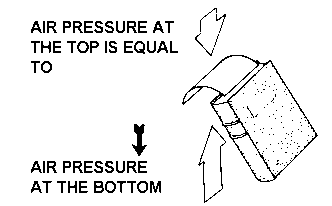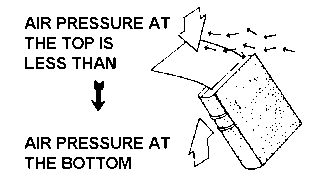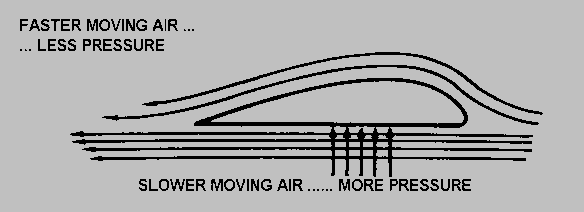 |
|||||
| Home | Research | For Teachers | HISTORY Level 1 Level 2 Level 3 |
PRINCIPLES Level 1 Level 2 Level 3 |
CAREER Level 1 Level 2 Level 3 |
| Gallery | Hot Links | What's New! | |||
| Web Administration and Tools | |||||
 |
|||||
| Home | Research | For Teachers | HISTORY Level 1 Level 2 Level 3 |
PRINCIPLES Level 1 Level 2 Level 3 |
CAREER Level 1 Level 2 Level 3 |
| Gallery | Hot Links | What's New! | |||
| Web Administration and Tools | |||||
![]()
Equipment:

The force that lifts an airplane and holds it up comes in part from the air that flows swiftly over and under its wings.
Make an airfoil (wing) by placing one end of the strip of paper between the pages of the book so that the other end hangs over the top as shown in diagram A. Move the book swiftly through the air, or blow across the top of the strip of paper. It flutters upward.
Hold the book in the breeze of an electric fan so the air blows over the top of the paper.
 Take the strip of paper out of the book. Grasp one end of the paper and set it
against your chin, just below your mouth. Hold it in place with your thumb and blow over
the top of the strip. The paper rises. Try the same thing after you have fastened a paper
clip on the end of the strip. See how many paperclips you can lift in this way.
Take the strip of paper out of the book. Grasp one end of the paper and set it
against your chin, just below your mouth. Hold it in place with your thumb and blow over
the top of the strip. The paper rises. Try the same thing after you have fastened a paper
clip on the end of the strip. See how many paperclips you can lift in this way.
It doesn't matter whether you move the air over the strip of paper by blowing or whether you move the paper rapidly through the air - either way it rises.
Press ![]() to see Animation
for paper airfoil.
to see Animation
for paper airfoil.
Bernoulli's principle states that an increase in the velocity of any fluid
is always accompanied by a decrease in pressure. Air is a fluid. If you can cause the air
to move rapidly on one side of a surface, the pressure on that side of the surface is less
than that on its other side.

Bernoulli's principle works with an airplane wing. In motion, air hits
the leading edge (front edge) of the wing. Some of the air moves under the wing, and some
of it goes over the top. The air moving over the top of the curved wing must travel
farther to reach the back of the wing; consequently it must travel faster than the air
moving under the wing, to reach the trailing edge (back edge) at the same time. Therefore
the air pressure on the top of the wing is less than that on the bottom of the wing.
Press ![]() to see Animation for Bernoulli's principle.
to see Animation for Bernoulli's principle.
Send all comments to ![]() aeromaster@eng.fiu.edu
aeromaster@eng.fiu.edu
© 1995-98 ALLSTAR Network. All rights reserved worldwide.
Updated: February 23, 1999